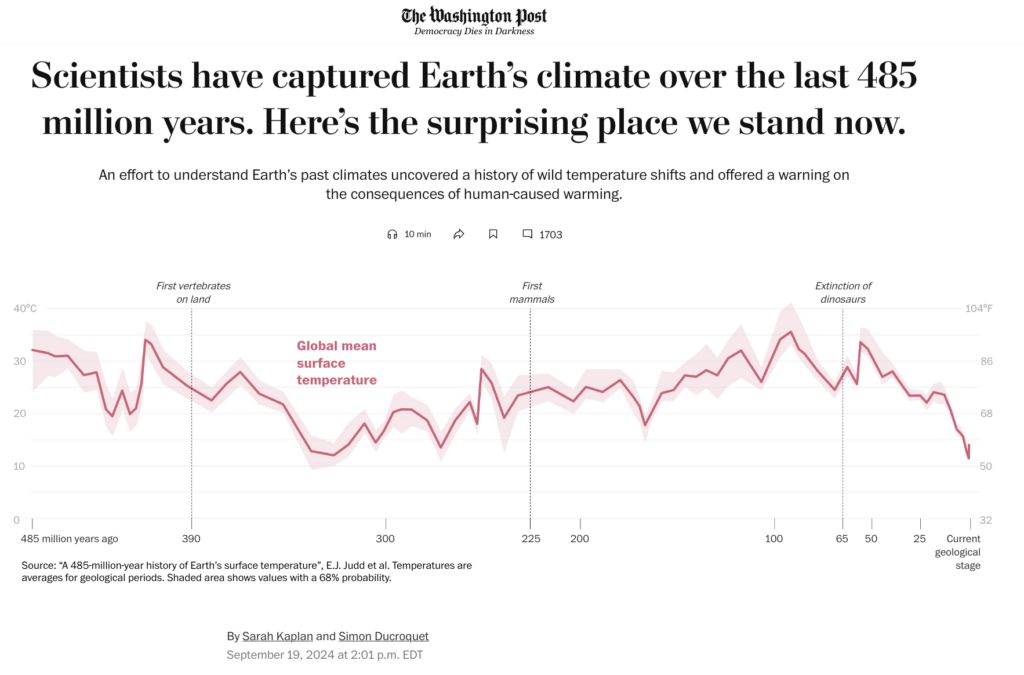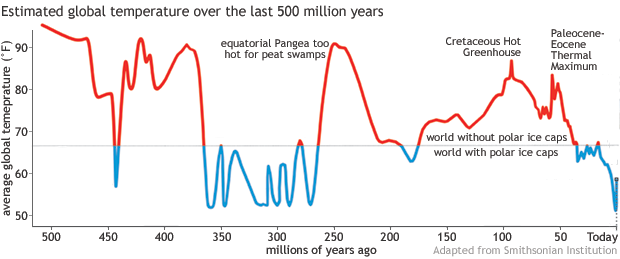
This chart makes the whole climate warming MEME completely absurd. We knew that anyway, simply because even my slight grasp of geology takes you there.
What we really need now is to adjust this chart for the Pleistocene Nonconformity which saw not a crustal plate movement but an abrupt crustal shift fifteen degrees southward through Hudson Bay. That reversed places both Ice Caps properly within fifteen degrees of the pole which actually stabilizes global temperatures and variation.
Not having this knowledge has misplaced most of our geological prehistory badly likely throwing our calculations hugely off. Understand that without it it was thought that the tropics went temperate.
WaPo features shock graph showing Earth cooling: ‘Scientists have captured Earth’s climate over last 485 million years’ – ‘Reveals world was in a much warmer state for most of the history of complex animal life’ – ‘History of wild shifts & far hotter temps than scientists previously realized’
9:21 pm
September 19, 2024 at 2:01 p.m. EDT
Excerpt: An ambitious effort to understand the Earth’s climate over the past 485 million years has revealed a history of wild shifts and far hotter temperatures than scientists previously realized — offering a reminder of how much change the planet has already endured and a warning about the unprecedented rate of warming caused by humans.
The timeline, published Thursday in the journal Science, is the most rigorous reconstruction of Earth’s past temperatures ever produced, the authors say. Created by combining more than 150,000 pieces of fossil evidence with state-of-the-art climate models, it shows the intimate link between carbon dioxide and global temperatures and reveals that the world was in a much warmer state for most of the history of complex animal life.
At its hottest, the study suggests, the Earth’s average temperature reached 96.8 degrees Fahrenheit (36 degrees Celsius) — far higher than the historic 58.96 F (14.98 C) the planet hit last year.
The revelations about Earth’s scorching past are further reason for concern about modern climate change, said Emily Judd, a researcher at University of Arizona and the Smithsonian specializing in ancient climates and the lead author of the study. The timeline illustrates how swift and dramatic temperature shifts were associated with many of the world’s worst moments — including a mass extinction that wiped out roughly 90 percent of all species and the asteroid strike that killed the dinosaurs.
The largest mass extinction happened 250 million years ago, when gases from volcanic eruptions – including CO₂ – raised Earth’s temperature by more than 18ºF (10ºC) in the span of about 50,000 years.
“We know that these catastrophic events … shift the landscape of what life looks like,” Judd said. “When the environment warms that fast, animals and plants can’t keep pace with it.”
At no point in the nearly half-billion years that Judd and her colleagues analyzed did the Earth change as fast as it is changing now, she added:
“In the same way as a massive asteroid hitting the Earth, what we’re doing now is unprecedented.”
485 million years of temperature turmoil
The timeline encompasses almost all of the Phanerozoic — the geologic eon that began with the emergence of multicellular, non-microscopic organisms and continues today.
It portrays a global climate that was more dynamic and extreme than researchers had imagined, said Jess Tierney, a climate scientist at the University of Arizona and co-author of the study. Compared with graphs based solely on climate models, which tend to depict smaller and slower swings in temperatures, the new timeline is full of sudden spikes and abrupt shifts.
But, in keeping with decades of past research on climate, the chart hews closely to estimates of carbon dioxide in the atmosphere, with temperatures rising in proportion to concentrations of the heat-trapping gas.
“Carbon dioxide is really that master dial,” Tierney said. “That’s an important message … in terms of understanding why emissions from fossil fuels are a problem today.”
At the timeline’s start, some 485 million years ago, Earth was in what is known as a hothouse climate, with no polar ice caps and average temperatures above 86 F (30 C). The oceans teemed with mollusks and arthropods, and the very first plants were just beginning to get a toehold on the land.
Temperatures began to slowly decline over the next 30 million years, as atmospheric carbon dioxide was pulled from the air, before plummeting into what scientists call a coldhouse state around 444 million years ago. Ice sheets spread across the poles and global temperatures dropped more than 18 degrees Fahrenheit (10 degrees Celsius). This rapid cooling is thought to have triggered the first of Earth’s “big five” mass extinctions — some 85 percent of marine species disappeared as sea levels fell and the chemistry of the oceans changed.
An even more dramatic shift occurred at the end of the Permian period, about 251 million years ago. Massive volcanic eruptions unleashed billions of tons of carbon dioxide into the atmosphere, causing the planet’s temperature to shoot up by about 18 F (10 C) in roughly 50,000 years. Acid rain fell across the continents; marine ecosystems collapsed as the oceans became boiling hot and depleted of oxygen.
“We know it to be the worst extinction in the Phanerozoic,” Tierney said. “By analogy, we should be worried about human warming because it’s so fast. We’re changing Earth’s temperature at a rate that exceeds anything we know about.”
The study also makes clear that the conditions humans are accustomed to are quite different from those that have dominated our planet’s history. For most of the Phanerozoic, the research suggests, average temperatures have exceeded 71.6 F (22 C), with little or no ice at the poles. Coldhouse climates — including our current one — prevailed just 13 percent of the time….
Modern humans
300,000 years ago
This is one of the more sobering revelations of the research, Judd said. Life on Earth has endured climates far hotter than the one people are now creating through planet-warming emissions. But humans evolved during the coldest epoch of the Phanerozoic, when global average temperatures were as low as 51.8 F (11 C).
Without rapid action to curb greenhouse gas emissions, scientists say, global temperatures could reach nearly 62.6 F (17 C) by the end of the century — a level not seen in the timeline since the Miocene epoch, more than 5 million years ago.
Though data assimilation is widely employed for modern weather forecasts and has been used to create reconstructions of temperature over shorter spans, the timeline published Thursday is the longest and most detailed scientists have ever produced.
It is also more accurate than other estimates, said Benjamin Mills, a paleoclimate researcher at the University of Leeds in England who was not involved in the study, because it uses the data assimilation approach.
“This will contribute to assessing the driving processes behind long-term temperature changes and the natural mechanisms of stabilizing or destabilizing Earth’s climate,” Mills wrote in an analysis that was published alongside the timeline.
‘All the things we don’t know’
The new temperature timeline raises as many questions as it answers, Wing said. Finding global average temperatures of more than 35 degrees Celsius implies that some parts of the planet were even hotter — during the warmest parts of the Cretaceous, for example, average temperatures in the interiors of continents might have reached 122 F (50 C). Even the hardiest modern species would wither in such a sweltering environment.
“It’s an indication of all the things we don’t know about how greenhouse climates work,” Wing said.
Perhaps organisms that evolved during hothouse eras were much better adapted to extreme heat than the plants and animals that live today, he added. Or maybe global temperatures were much more uniform during those periods, with few areas getting much colder or warmer than the average.
Michael Mann, a climate scientist at the University of Pennsylvania who is known for his analyses of past global temperatures, said he was also surprised by the suggestion that the planet got so warm.
The finding supports many scientists’ concern that feedback loops in the Earth system could lead to much higher temperatures than most climate models predict, he wrote in an email. But it’s also possible that the data assimilation assumes too much warming and is missing factors that might forestall a runaway greenhouse effect.
Related:
Carbon Dioxide Is Not the “Control Knob” of the Climate
There is a lack of connection between higher levels of CO2 and warming. During the Ice Age, CO2 levels were ten times higher than they are today.9
There are many, many factors that impact climate—including volcanoes, wind oscillations, solar activity, ocean cycles, volcanoes, the tilt of the Earth’s axis, and land use. CO2 is just one factor, not the control knob of the climate.
University of Pennsylvania geologist Dr. Robert Giegengack has declared, “CO2 is not the villain that it has been portrayed.”
Today’s levels of roughly four hundred parts per million (PPM) of CO2 are not alarming. In geologic terms, today’s CO2 levels are among the lowest in earth’s history.10
“Climate change is governed by hundreds of factors or variables, and the very idea that we can manage climate change predictably by understanding and manipulating at the margins one politically selected factor (CO2), is as misguided as it gets. It’s scientific nonsense,” University of London professor emeritus Philip Stott has noted.
Atmospheric scientist Hendrik Tennekes, a pioneer in the development of numerical weather prediction and former director of research at the Netherlands’ Royal National Meteorological Institute, declared: “I protest vigorously the idea that the climate reacts like a home heating system to a changed setting of the thermostat: just turn the dial, and the desired temperature will soon be reached.”
According to Greenpeace co-founder Dr. Patrick Moore: “We had both higher temperatures and an ice age at a time when CO2 emissions were 10 times higher than they are today.”
MIT climate scientist Lindzen’s 2020 study debunked the “implausible claim that a change in one variable—CO2—is predominantly responsible for altering global temperatures.”12 The study, which was published in the European Physical Journal, found that a “doubled- CO2 effect has less than 1/5th of the impact that the net cloud effect has. And yet we are asked to accept the ‘implausible’ claim that change in one variable, CO2, is predominantly responsible for altering global temperatures.”

No comments:
Post a Comment